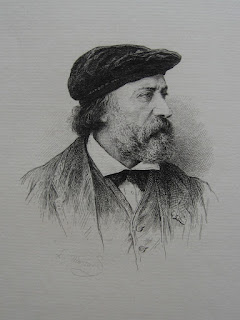Charles Chaplin, Daubigny
Etching, 1862
Béraldi 3
Daubigny was a very active printmaker, creating 127 etchings, aquatints, and drypoints, 18 clichés-verre, and 4 lithographs. I have six of his etchings to share with you.
Charles-François Daubigny, Le marais
Etching, 1851
Delteil/Melot 84
The earliest etching I have by Daubigny is Le marais, dating from 1851 though my copy is from the 1874 printing for the Gazette des Beaux-Arts. Although this is already no. 84 in the catalogue raisonné of Daubigny's etchings, it is actually right at the beginning of his true career as an original etcher, many of the earlier works being illustrative plates of little significance. I like the storks standing placidly in the marsh water, the twisted trees, and the skein of wild ducks in the sky. Incidentally, Michel Melot, in his Graphic Works of the Pre-Impressionists, gives the print-run of the Gazette des Beaux-Arts impression as 750 copies. I've often seen this figure given for the GBA, but I can't quite bring myself to accept it; I always give c.1500 copies as the print-run for the Gazette, which I think is probably more than were actually published, but 750 seems very low. However Melot was curator of the Département des Estampes at the Bibliothèque Nationale, so should know better than me.
Charles-François Daubigny, Soleil couchant
Etching, 1859
Delteil/Melot 92
Soleil couchant dates from 8 years later, during which time Daubigny has only added eight etchings to his tally, but in which his art has developed a looser feel, and a more pronounced concern with light effects.
Charles-François Daubigny, Les vendanges
Etching, 1865
Delteil/Melot 117
Les vendanges, from 1865, is a charming rural scene, with peasants crushing grapes in large vats, while cows rest placidly beside them, at the edge of the vineyard. My copy was reprinted from the original plate in 1923 for the art revue Byblis by the Chalcographie du Louvre; this was one of 27 copper plates donated to the Louvre by the artist's family.
Charles-François Daubigny, Le pré des graves à Villerville
Etching, 1875
Delteil/Melot 124
Charles-François Daubigny, Pommiers à Auvers
Etching, 1877
Delteil/Melot 126
Etching, 1877
Delteil/Melot 127
These last three etchings show a big shift from the pleasant but rather conventional aesthetic of Les vendanges. They show, in fact, Charles-François Daubigny, the Pre-Impressionist. All three of them were created shortly after the First Impressionist Exhibition of 1874. It's not very likely that Daubigny was directly influenced by that exhibition, but he was a great supporter of the radical new work of the Impressionists. He resigned as a member of the jury of the Salon de Paris in 1865 when works by Cézanne and Pissarro were rejected, and resigned again in 1870 when Monet was rejected; it was Daubigny's suggestion that the spurned artists set up their own Salon de Réfusées. Daubigny was on friendly terms with Pissarro and Monet - Monet even copied Daubigny's idea of creating a makeshift painting studio on a boat. The three etchings above are three of the last four Daubigny ever made, right at the end of his life, and they show him leaping into the impressionist unknown. All were made for L'Illustration Nouvelle, published by Maison Cadart (by then run by Alfred Cadart's widow, Célonie-Sophie). Michel Melot calls the penultimate print, Pommiers à Auvers, "the most 'Impressionist' of Daubigny's etchings, done at a time when Pissarro had already begun to engrave". But I personally think that Claire de lune à Valmondois (Moonlight at Valmondois), the very last etching of Daubigny, is the most perfectly Impressionist, in its obsession with light, the Monet haystacks, the whole feel of a fleeting moment captured forever. According to Alfred de Lostalot, writing in the Gazette des Beaux-Arts, which also published this etching to mark Daubigny's passing, the plate was drawn two months before the artist's death. "He wished to burnish it, that is, tone down the haystacks and the tree-covered mountainsides that bound the horizon: death did not leave him time to do so." So maybe the illusion of Impressionism is simply the result of infirmity preventing Daubigny giving the plate a more "finished" feel. But I suspect not. He may have wondered about toning it down, but he didn't do so, probably because inside himself he knew it was as finished as it needed to be.
Léopold Massard, Charles Daubigny
Etching, 1882




















1 comment:
"When Fields in the Month of June was shown in the Salon of 1874, Daubigny’s rapid juxtaposition of brushstrokes, absence of detail, spots of brilliant color, and immediacy represented a dramatic move away from the classical polish of official Salon painting." A friend of mine, who had never heard of Daubigny, bought a print of it the first time she saw the painting.
Neil, this is what the Herbert Johnson Museum at Cornell University in Ithaca, NY, has to say about Daubigny's 1874 painting "Fields In The Month Of June." It is quite as you have described Daubigny's evolving style. The painting was a gift to the museum from a Cornell Alumni, Class of 1911. We are fortunate to have it here in upstate New York!
You provoke thought, as usual, Neil. Thanks a bunch.
Post a Comment